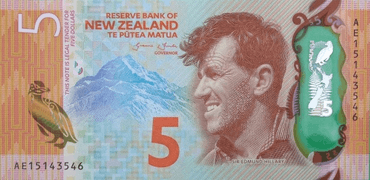New Zealand five-dollar note
| (New Zealand) | |
|---|---|
| Value | $5 New Zealand Dollar |
| Width | 135 mm |
| Height | 66 mm |
| Security features | Window, Shadow image |
| Paper type | Polymer |
| Years of printing | 1967–present[1] |
| Obverse | |
 | |
| Design | Sir Edmund Hillary |
| Design date | October, 2015[2] |
| Reverse | |
| Design | Hoiho, Campbell Island |
| Design date | October, 2015 |
The New Zealand five-dollar note was issued on 10 July 1967 when New Zealand decimalised its currency, changing from the New Zealand pound to the New Zealand dollar.
Design
First issue (1967–1982)
On the front of the notes Queen Elizabeth II is pictured. There is a watermark of Captain James Cook. On the back of the note is a tui, which is a bird that eats nectar. The plant the bird is perched on is a kōwhai, which is a tree with honey blossoms.
Second issue (1982–1990)
The colours and Elizabeth II's portrait were the only major changes.
Third issue (1990–1999)
The old notes were completely overhauled and have the same portraits and design as the fourth issue. There is a metallic strip, and a latent image was added as well; these do not appear on the newer notes. This note is different from the fourth series because it was issued in cotton, not polymer.[3][4]
Fourth issue (1999–2015)
The Reserve Bank of New Zealand issued the note because the note will last four times longer than its counterpart, the paper banknote. The Bank also said the notes are non-porous, meaning they do not absorb liquids; therefore, they are much cleaner. The notes have better security features than the cotton-based notes, which also deters counterfeiters.[1]
On the front of the note is the explorer Sir Edmund Hillary. Aoraki / Mount Cook, the tallest mountain in New Zealand 12,316 feet (3,754 m), can be seen on the left of the bill. Hillary was one of the first two individuals known to reach summit of Mount Everest and the first one to have been to South Pole, North Pole and on the summit of Everest. The Massey Ferguson tractor driven by Hillary to the pole can be found in the lower left corner next to the transparent window. Hillary has been the only New Zealander to appear on a banknote during his or her lifetime, in defiance of the established convention for banknotes of using only depictions of deceased individuals, and current heads of state.
On the back of the bill is a scene from Campbell Island which is south of Stewart Island / Rakiura. The penguin on the bill is the hoiho, which is native to New Zealand. The subantarctic lily (Bulbinella rossii) with yellow flower heads is also on the back. [5]
the reason why the "five dollars" was created was because it was easier to split the "ten dollars"
Series 7
New $5 and $10 banknotes were released in October 2015 as part of the Series 7 banknote release. The remaining three banknote denominations (i.e. $20, $50, $100) in Series 7 will be released in May 2016.
Security features
The polymer note has a watermark of Elizabeth II on the right side. There are two transparent windows with images of a fern, on the left, and on the right. When held up to the light the window will show a "5" in its center, and images of ferns printed on each side will line up perfectly. When the note is put under UV Light a yellow patch should appear with the number "5" through the use of fluorescent dyes.[6]
References
- 1 2 "New Zealand's bank notes". Reserve Bank of New Zealand. Retrieved 20 December 2012.
- ↑ Reserve Bank of New Zealand
- ↑ "The history of bank notes in New Zealand". Reserve Bank of New Zealand. Retrieved 20 December 2012.
- ↑ "New Zealand banknotes". atsnotes.com. Retrieved 20 December 2012.
- ↑ "Explaining New Zealand's Currency" (PDF). Reserve Bank of New Zealand. Retrieved 20 December 2012.
- ↑ "The New Polymer Bank Notes" (PDF). Reserve Bank of New Zealand. Retrieved 20 December 2012.